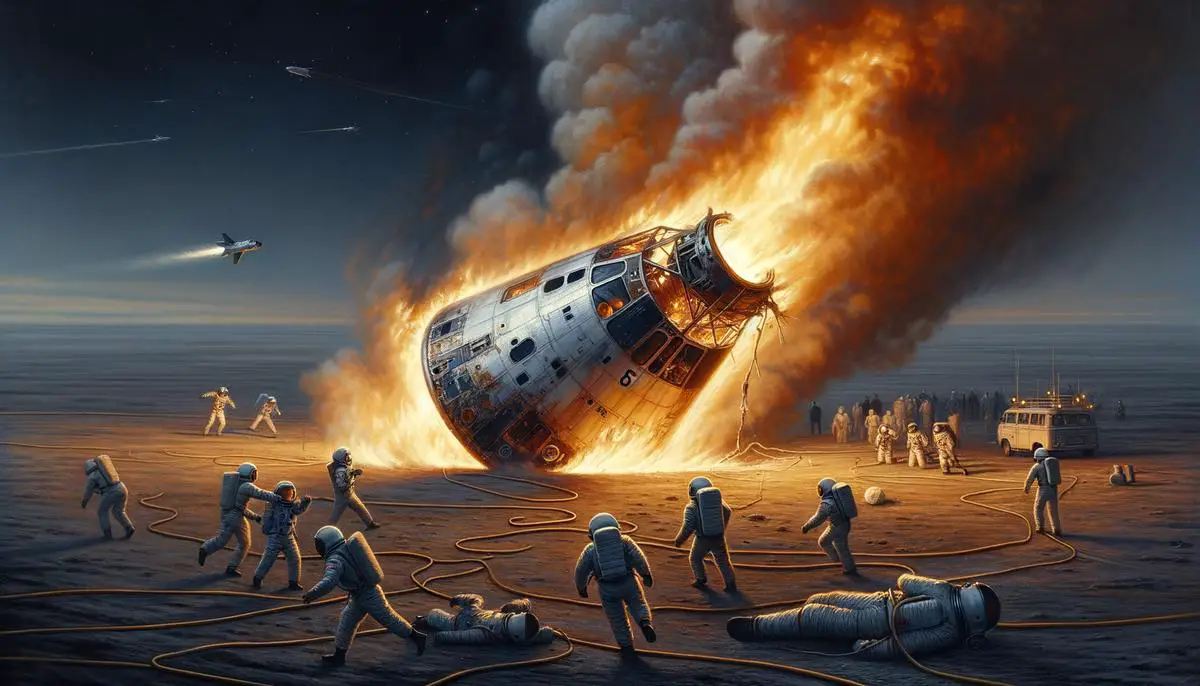The Apollo 1 mission, poised at the dawn of the space age, symbolized a pinnacle of human ambition and ingenuity. With the United States fervently pursuing lunar exploration supremacy against the backdrop of the Cold War, this mission was charged with the hopes and dreams of a nation eager to push the boundaries of the known world. As preparations unfolded, a vibrant tapestry of optimism and meticulous planning enveloped the mission, underscoring the collective spirit of an era that sought to leap into the cosmos. This undertaking was not merely a quest for celestial dominance but a testament to human resilience and the relentless pursuit of knowledge.
Contents
The Prelude to Tragedy
Embarking on the Journey to the Moon: The Aspirations and Preparations of Apollo 1
In the heart of the 1960s, a period brimming with innovation and the thirst for exploration, the United States set its sights on a goal that was as audacious as it was visionary – landing a man on the Moon. This grand dream laid the foundation for Apollo 1, a mission symbolizing the inception of mankind’s most daring journey into the unknown cosmos. Apollo 1 was not just a mission; it was a testament to human aspiration, a beacon of the unyielding human spirit yearning to break the bonds of Earth and venture into the vastness of space.
The raison d’être of Apollo 1 was clear – to test the very limits of human capability and technological prowess, setting the stage for the lunar dream. The mission was designed to be the first manned test of the Apollo Command/Service Module in orbit, a crucial step toward ensuring that a lunar landing could be achieved. It represented a critical juncture in the Apollo program, serving as the vital link between ground-based testing and the actual lunar mission. Every aspect of Apollo 1 was engineered with precision, aiming to validate the integrity of the spacecraft’s design, its life support systems, and its ability to sustain human life in the unforgiving vacuum of space.
The astronauts chosen for this pioneering mission – Virgil “Gus” Grissom, Edward H. White II, and Roger B. Chaffee – were not just pilots. They were visionaries, embodiments of courage and the relentless pursuit of knowledge. Their selection was a meticulous process, reflecting not only their exemplary skills and bravery but also their unwavering commitment to advancing human exploration. They were to be the torchbearers, the first to usher in a new era of space travel, setting the precedent for all future endeavors beyond Earth’s atmosphere.
In preparation for Apollo 1, exhaustive tests were conducted, pushing the boundaries of what was known and challenging the limits of human ingenuity. The spacecraft underwent rigorous examination, from the resilience of its structure to the efficacy of its communication systems. Simulations were performed, recreating every possible scenario the crew might face in the void of space. These preparations were monumental, involving countless individuals from engineers to scientists, all united by a shared purpose – to ensure the mission’s success and the safety of its crew.
Yet, the journey of Apollo 1 was marked by tragedy. On January 27, 1967, a fire during a pre-launch test claimed the lives of Grissom, White, and Chaffee. This moment of profound loss became a pivotal point in space exploration history, a stark reminder of the risks inherent in pushing the frontiers of human knowledge. The sacrifices of these three heroes were not in vain; their legacy became a catalyst for change, leading to significant enhancements in spacecraft safety and design. Their spirit continued to live on, guiding the subsequent missions of the Apollo program towards achieving the lunar dream they had valiantly sought to initiate.
Apollo 1, in its aspirations and preparations, encapsulated the essence of exploration – the triumphs, the setbacks, and the indomitable spirit of humanity to reach beyond the skies. It laid the groundwork for the monumental achievements that followed, forever altering our relationship with the cosmos. The mission’s legacy is a testament to the power of dreams, the importance of perseverance, and the boundless potential of the human spirit to explore the unknown.

January 27, 1967: A Day of Catastrophe
On that ill-fated day of January 27, 1967, the world was poised on the edge of a new era. The mission known as Apollo 1 was underway, a beacon of hope and ambition in the quest to conquer the final frontier. Embedded within this mission were three pioneers: Gus Grissom, a seasoned astronaut; Ed White, the first American to walk in space; and Roger Chaffee, preparing for his first space voyage. Together, they embodied the zenith of human determination and bravery.
As countdown rehearsals commenced at Cape Kennedy (now Cape Canaveral), Florida, the Apollo 1 crew was sealed inside the command module, simulating a launch sequence that would propel humanity further into the cosmos. This specific test was a “plugs-out” exercise, designed to run the spacecraft entirely on its own power, mirroring the conditions of an actual launch.
Unbeknownst to the heroes within and the team on the ground, tragedy lurked in the shadows. Housed within the command module was a highly oxygen-rich atmosphere, a condition conducive for extreme, rapid combustion. In contrast to the Earth’s atmospheric balance that discourages such sudden ignitions, the pure oxygen environment within the spacecraft was a ticking time bomb.
Minutes into the test, a distressing call broke through the comm link, “Fire, I smell fire.” Seconds later, chaos ensued as flames quickly engulfed the command module. The spacecraft, designed to protect its inhabitants from the vacuum of space, became a prison as the hatch, complicated by its intricate sealing mechanism designed for zero gravity, resisted attempts at a timely rescue.
The catastrophe unfolded in less than a minute, claiming the lives of Grissom, White, and Chaffee. The aftermath was a stark, smoldering reminder of humanity’s fragility in the face of the unknown. The nation mourned as the somber reality set in; these pioneers paid the ultimate price in humanity’s pursuit of the stars.
In the wake of this devastating event, the space community was enveloped in a period of introspection and overhaul. The Apollo 1 fire became a grim lesson in the imperatives of space safety. Investigations revealed the fire’s cause: an electrical spark that found its catalyst in the oxygen-rich atmosphere, further exacerbated by flammable materials within the cabin. This finding led to widespread changes in spacecraft design, including the incorporation of a nitrogen-oxygen blend to minimize fire risk, the overhaul of the command module’s hatch to ensure rapid evacuation, and the replacement of flammable materials with those that were fire-resistant.
This tragic moment served as a harsh tutor, molding the future of space exploration with lessons inked in sacrifice. The ethos of Apollo 1’s crew, their unyielding courage, and their ultimate sacrifice, fueled the resolve to continue the journey beyond Earth. The Apollo program, galvanized by their memory, carried forth their legacy, eventually achieving the historic lunar landing with Apollo 11 in 1969.
Thus, even in the face of profound loss, the Apollo 1 mission profoundly reshaped the course of human space exploration. It stands as a testament to the relentless human spirit and the unbreakable will to reach beyond the known, to ensure that the lives lost were not in vain but were the cornerstone upon which the safety and success of future missions could be built. Apollo 1, in its heartache and legacy, forever altered our approach to conquering the unknown, ensuring that humanity would continue to reach for the stars, grounded in the wisdom forged from its sacrifice.

Investigation and Findings
In the wake of the Apollo 1 tragedy, an exhaustive investigation was launched to uncover what had led to the devastating fire. This probe marked a pivotal moment in space exploration, aimed at ensuring such a catastrophe would never recur.
At the heart of the probe was an intense scrutiny of the event’s specifics. Investigators showed a particular focus on the spacecraft’s design, identifying the primary culprit: the cabin’s atmosphere. Unlike later missions which would use a mixture of oxygen and nitrogen, the Apollo 1 command module was pressurized solely with pure oxygen, a condition ideal for the rapid spread of flames. Once ignited, the fire found ample fuel within the highly flammable materials used in the cabin’s construction, from the astronauts’ nylon suits to the spacecraft’s interior components.
Moreover, the investigation revealed concerning design flaws in the spacecraft’s hatch. The inward-opening design made it impossible for the astronauts to force the hatch open against the internal pressure once the fire started, trapping them inside. This tragic oversight underscored the need for drastic design changes.
Following these harrowing revelations, the ethos surrounding spacecraft design and mission preparation underwent a radical transformation. No longer would the rush toward ambitious goals overshadow the meticulous attention to safety and reliability. Changes implemented post-investigation included a shift to a less hazardous atmosphere composed of mixed gases for the cabin, the replacement of flammable materials with fire-resistant alternatives, and the redesign of the hatch to allow for quick evacuation in emergency situations.
These reforms also extended to procedural and operational modifications. Enhanced safety protocols were established, including more rigorous testing and pre-flight checks. The tragedy drove home the critical importance of emergency preparedness, leading to the development of more effective training for astronauts in crisis scenarios.
The legacy of Apollo 1, immortalized by its emblematic patch adorned with the names Grissom, White, and Chaffee, became a testament to the resilience and determination of the human spirit. The adjustments and advancements inspired by its investigation paved the way for the triumphant Apollo 11 lunar landing, a feat that might not have been achieved had the space community not taken the hard-learned lessons of Apollo 1 to heart.
Thus, through the prism of tragedy, lasting enhancements emerged, redefining the trajectory of space exploration. The sustained commitment to ensuring the utmost safety and preparedness in missions underscored the indelible impact of Apollo 1, immortalizing its role in propelling humanity to new frontiers. The sacrifices of Grissom, White, and Chaffee were not in vain, their legacy living on in the safer, more secure voyages that followed – a fitting tribute to their contribution to space exploration.

The Legacy of Apollo 1
In the heart of every monumental challenge, like the Apollo 1 disaster, lies the seed of transformation. This tragic event on January 27, 1967, didn’t just rock the National Aeronautics and Space Administration (NASA) but the whole world, reshaping the future of space exploration in ways most could never have anticipated.
The Apollo 1 mission, poised to boldly pave the way for lunar landing, instead, became a somber reminder of the perilous nature of space exploration. The fire that claimed the lives of astronauts Gus Grissom, Ed White, and Roger Chaffee during a routine pre-launch test was a wake-up call, underlining the complexity and risks involved in sending humans off-Earth.
Following this heartbreak, the immediate aftermath was an exhaustive investigation, where scrutiny fell heavily on the Apollo spacecraft’s design. Among the primary culprits identified was the spacecraft’s hatch. During the crucial moments of the fire, the hatch’s complicated design proved fatally inefficient for quick egress. This was a devastating oversight in design, considered unacceptable in the wake of the tragedy.
The probe dug deeper, unraveling critical design flaws that contributed to the disaster. It was revealed that the command module’s atmosphere, composed entirely of oxygen, greatly increased the fire risk. Additionally, the materials used within the cabin, found to be highly flammable, worsened the scenario significantly. These insights were sobering, marking a pivotal point in space mission protocols and design philosophy.
What followed was a period of rigorous introspection and change within NASA and the broader space community. The Apollo 1 tragedy forged a renewed commitment to safety, spurring comprehensive overhauls in spacecraft design and mission preparation. Key reforms emerged, notably the redesign of the hatch to ensure quick and easy access in emergencies. The atmosphere within the spacecraft was also reconsidered, leading to a safer mix of oxygen and nitrogen to mitigate fire risk.
Moreover, the materials chosen for the spacecraft underwent a thorough review. Only those with low flammability were selected for future missions, reducing the likelihood of a similar catastrophe. Operational procedures were not left untouched; enhanced safety protocols, rigorous training regimens, and more scrupulous inspection processes became the norm, embedding a culture of safety that permeates space exploration to this day.
These transformations had a lasting impact, not just on the Apollo missions but on all subsequent human spaceflight endeavors. The lessons learned from Apollo 1 reshaped NASA’s approach, embedding resilience and an unwavering commitment to preserving astronaut lives above all else. It is a poignant reminder that progress often comes at a steep price, but the legacy of Apollo 1 lives on, fueling advancements that have made succeeding missions safer and more successful.
In essence, the Apollo 1 disaster, while a potent reminder of the risks inherent in space exploration, became a catalyst for crucial innovations in spacecraft design, operational safety, and mission planning. This introspective journey forged a safer path for astronauts, ensuring the indomitable spirit of exploration could thrive, underpinned by a deep-seated commitment to never repeat the harrowing lessons of the past. In the shadow of loss, the space community found a way to honor Grissom, White, and Chaffee: by making space travel as safe as human ingenuity allows, ensuring their sacrifice was not in vain but a stepping stone to a brighter, explorative future.

Reflections: The Human Aspect
Navigating the emotional turbulence and societal shifts ignited by the Apollo 1 fire offers a poignant look into the collective human experience during one of space exploration’s darkest hours. The calamity, occurring on January 27, 1967, not only halted the ambitious strides towards the moon but also draped the nation, and indeed the world, in a shroud of mourning and reflection.
The Apollo 1 fire, claiming the lives of astronauts Gus Grissom, Ed White, and Roger Chaffee, was more than a tragic footnote in the annals of space exploration; it was a stark reminder of the perils inherent in pushing the boundaries of human knowledge and capability. The nation found itself grappling with a profound sense of loss, as these three men, who had become symbols of humanity’s quest beyond the confines of Earth, were suddenly and violently taken. This sense of loss permeated beyond the immediate families of the fallen heroes to touch countless individuals who had followed their journey with hope and admiration.
Society’s reaction to the tragedy was multifaceted. There was, understandably, an outpouring of grief. Memorials and tributes poured in from all corners of the globe, highlighting the global impact of the disaster. The astronauts were not only American heroes but also global icons of bravery and the spirit of exploration. Their untimely deaths served as a somber reminder of the risks involved in exploring the unknown, sparking conversations about whether the quest to conquer space was worth the cost in human lives.
However, interwoven with the grief was a palpable determination. The Apollo 1 disaster brought about an unyielding resolve within NASA and the broader space community to ensure that the astronauts’ sacrifice was not in vain. This tragedy spurred an era of introspection within NASA, leading to rigorous scrutiny and overhaul of spacecraft design, safety protocols, and mission preparation. The fire became a catalyst for change, compelling NASA to reevaluate and enhance its safety measures, which undeniably played a crucial role in the success of subsequent missions, including the historic Apollo 11 moon landing.
The societal repercussions of the Apollo 1 tragedy also extended to the realm of education and policy. It shed light on the necessity of robust oversight in technological advancements and the importance of preparing for the unforeseen. The disaster underscored the stark reality that in humanity’s quest to explore and innovate, safety should never be compromised. Lessons learned from Apollo 1 infused into educational curriculums and policy frameworks aimed at fostering a culture of meticulousness and accountability in fields that push the envelope of human capability.
Moreover, the Apollo 1 tragedy etched itself into the societal consciousness as a narrative of human resilience in the face of adversity. While it highlighted the vulnerabilities inherent in human endeavors, it also underscored the indomitable spirit of not only the astronauts but also those who choose to continue their legacy. The story of Apollo 1 serves as a poignant reminder of the highs and lows of human exploration and the unyielding spirit that drives humanity to persist, learn, and eventually triumph in the quest for knowledge and discovery.
In essence, the emotional and societal repercussions of the Apollo 1 fire were complex and enduring. They wove a narrative of loss, reflection, determination, and resilience that resonated deeply with individuals and communities worldwide. This tragic event served as a crucial turning point, shaping the future of space exploration through lessons learned in the hardest way possible but also reminding us of the courage and spirit that define human endeavors.

The Apollo 1 tragedy, while a stark reminder of the perils inherent in the conquest of space, ultimately catalyzed a profound transformation in the realm of space exploration. Through the ashes of this calamity arose a renewed commitment to safety, innovation, and the indomitable spirit of inquiry that defines our ventures into the unknown. The legacy of Apollo 1, etched into the annals of history, serves as a solemn vow to honor the courage of those who dare to dream beyond the confines of Earth. It reminds us that in the heart of tragedy lies the seed of progress, urging us forward towards new horizons with wisdom and resolve.
